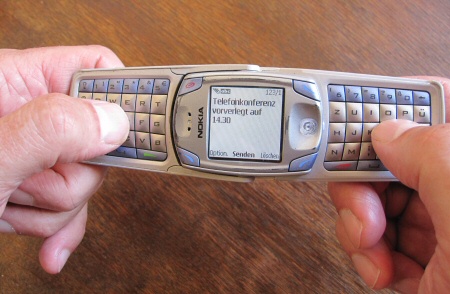There are many reasons why the fans of analog media have nothing to fear in a digital world – aside from the fact that you can’t wrap a fish in an iPad. But the even our digital world will no longer be what it once was. Why? Because the iPad is so analog.
I was faithful to my Nokia 6820 for a very long time. Even after Nokia had abandoned it and the stores no longer had them in stock, I purchased two used devices so that I could extend the product lifecycle of this cell phone species for a couple of years. A short while back, however, I surrendered and belong now to the iPhoniacs, who after a car crash would first move to see if everything was okay with their iPhone.

We all wish that smartphones could be small computers. And above all, I expect computers to be designed for typing. My 6820 was really nifty in that sense. Thanks to its pocket format, slidable keyboard and otherwise clean design, I could quickly send short e-mails (i.e. text messages) and easily jot down ideas and thoughts. Plus, I rarely ever made a typo.
Unfortunately, that is not the case with my iPhone. So far, it seems that I do more deleting than typing. Two letters ahead, one letter back. When I’ve discussed this problem with other iPhone users, they simply shake their heads in disbelief and ask how long I have been using it. When I tell them ‘two months’, they simply chuckle lightly, pat me on the shoulder, and say that I will get used to using the keyboard soon. My iPhone doesn’t get along well with my car, the voice quality is a step down from my Nokia, and there are a few other objective disadvantages that sometimes annoy me. But I love it – unconditionally.
As the iPhone’s big brother, the iPad, was launched in Germany, I was probably the first to buy one. (Hehe.) In fact, my growing dependency on Apple products is beginning to scare me. I almost feel that there is something totalitarian about it. I don’t like it but I simply just can’t resist. Why are two black panes of glass – one as small as a phone and the other about the size of a computer – suddenly so fascinating to so many people? What is it about those shiny screens that are constantly smudged with oily streaks from typing, pinching or wiping with our fingers? Right that is the reason itself.

Wanting to touch the things that we see is a human trait. (A scene from the movie “Avatar” copied from this music video.)
Do you remember that scene from Avatar when Jake taps a dragonfly-like creature which suddenly lights up like a firefly and takes off like a helicopter? With the same innocent gesture of childlike curiosity, Jake touches trumpet-like plants that recoil from the size of a grown man to a tiny, little hole in the ground. Jake enjoys this so much that he continues to touch all of the plants until they have disappeared into the earth.
Our index finger likes to touch the things at which it is pointing.That is nothing new. Touch screens aren’t new either. What is new, however, is that Apple has incorporated even more human gestures into the way that we work with computers. Most animals cannot oppose their thumbs to their index fingers. Humans, however, can and we do it rather well, too. Our entire manual ability depends on this special anatomic function. Apple uses this typical human opposition for an analog gesture that satisfies our most outstanding mannerism – the search for insight. By spreading our thumb and index finger apart or moving them together on an iPhone or iPad, we can zoom in or out of the content that we see. We change detail, size and scale – all of which are important building blocks in the realization process.
James Cameron’s parable of the Na’vi, the aboriginal people of the planet pandora, living in tune with nature, also applies for modern mankind. We also want to become in tune with our computers. In order to do, however, our computers must become more analog. Using cultural techniques, we have been able to communicate with computers for a long time. We first learned to speak, write and then type. The mouse has also made our relationship to computers much friendlier. It has extended our index finger. In fact, clicking a mouse is just an abstract way of touching something. Nevertheless, keyboard shortcuts are and remain the fastest way to communicate with a computer. The perceived simplification of using an iPhone or iPad also means that something was designed to be simpler – in the sense of being more primitive. But that also involves more work. As far as Business Intelligence is concerned we realize: The archaic paradigms for usability will inspire us to create an even more user-friendly and tactile interface for report consumers. If this will inspire us to create a better interface for report authors we still do research.
